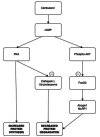Clenbuterol Abuse in Bodybuilding and Athletics: Unsupervised Use, Psychological Motivations, and Health Consequences
- PMID: 40575216
- PMCID: PMC12200009
- DOI: 10.7759/cureus.84904
Clenbuterol Abuse in Bodybuilding and Athletics: Unsupervised Use, Psychological Motivations, and Health Consequences
Abstract
Clenbuterol is a β2-adrenergic agonist originally developed as a bronchodilator but is now often used without supervision for its perceived muscle-building and fat-burning effects. Although it is not approved for human use in many regions, it continues to be used in bodybuilding and athletics for physique and performance enhancement. Its appeal lies in its ability to influence muscle development and fat metabolism. Many individuals use it due to psychological motivators such as body image concerns and a desire for rapid physical changes. However, its use may result in side effects involving the heart, muscles, and overall physical well-being, such as arrhythmias, hypertension, and muscle spasms. In some cases, it has also been linked to accidental exposure through contaminated food. The widespread misuse of clenbuterol raises ethical concerns in competitive environments. More discussion is needed around developing safer methods of achieving similar goals, and there is a need for increased public awareness and caution regarding its use.
Keywords: anabolic agents; athletes; bodybuilding; clenbuterol; doping; performance-enhancing drugs; β2-adrenergic agonist.
Copyright © 2025, Kataveni et al.
Conflict of interest statement
Conflicts of interest: In compliance with the ICMJE uniform disclosure form, all authors declare the following: Payment/services info: All authors have declared that no financial support was received from any organization for the submitted work. Financial relationships: All authors have declared that they have no financial relationships at present or within the previous three years with any organizations that might have an interest in the submitted work. Other relationships: All authors have declared that there are no other relationships or activities that could appear to have influenced the submitted work.
Figures

Similar articles
-
Comparison of the effectiveness of inhaler devices in asthma and chronic obstructive airways disease: a systematic review of the literature.Health Technol Assess. 2001;5(26):1-149. doi: 10.3310/hta5260. Health Technol Assess. 2001. PMID: 11701099
-
A rapid and systematic review of the clinical effectiveness and cost-effectiveness of paclitaxel, docetaxel, gemcitabine and vinorelbine in non-small-cell lung cancer.Health Technol Assess. 2001;5(32):1-195. doi: 10.3310/hta5320. Health Technol Assess. 2001. PMID: 12065068
-
Adverse effects of beta-agonists: are they clinically relevant?Am J Respir Med. 2003;2(4):287-97. doi: 10.1007/BF03256657. Am J Respir Med. 2003. PMID: 14719995
-
Single-incision sling operations for urinary incontinence in women.Cochrane Database Syst Rev. 2017 Jul 26;7(7):CD008709. doi: 10.1002/14651858.CD008709.pub3. Cochrane Database Syst Rev. 2017. Update in: Cochrane Database Syst Rev. 2023 Oct 27;10:CD008709. doi: 10.1002/14651858.CD008709.pub4. PMID: 28746980 Free PMC article. Updated.
-
Carbamazepine versus phenytoin monotherapy for epilepsy: an individual participant data review.Cochrane Database Syst Rev. 2017 Feb 27;2(2):CD001911. doi: 10.1002/14651858.CD001911.pub3. Cochrane Database Syst Rev. 2017. Update in: Cochrane Database Syst Rev. 2019 Jul 18;7:CD001911. doi: 10.1002/14651858.CD001911.pub4. PMID: 28240353 Free PMC article. Updated.
References
-
- Beta(2) -adrenergic agonist clenbuterol increases energy expenditure and fat oxidation, and induces mTOR phosphorylation in skeletal muscle of young healthy men. Jessen S, Solheim SA, Jacobson GA, Eibye K, Bangsbo J, Nordsborg NB, Hostrup M. Drug Test Anal. 2020;12:610–618. - PubMed
-
- Complete post-mortem investigations in a death involving clenbuterol after long-term abuse. Kintz P, Gheddar L, Ameline A, Dumestre-Toulet V, Verschoore M, Comte J, Raul JS. J Anal Toxicol. 2019;43:660–665. - PubMed
-
- Β-2 agonists as misusing drugs? Assessment of both clenbuterol- and salbutamol-related European Medicines Agency pharmacovigilance database reports. Milano G, Chiappini S, Mattioli F, Martelli A, Schifano F. Basic Clin Pharmacol Toxicol. 2018;123:182–187. - PubMed
-
- Analysis of non-hormonal nutritional supplements for anabolic-androgenic steroids - results of an international study. Geyer H, Parr MK, Mareck U, Reinhart U, Schrader Y, Schänzer W. Int J Sports Med. 2004;25:124–129. - PubMed
Publication types
LinkOut - more resources
Full Text Sources
